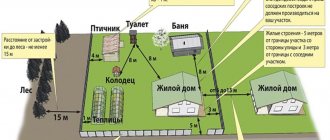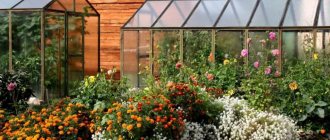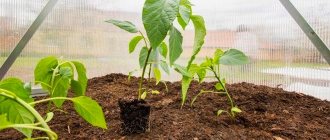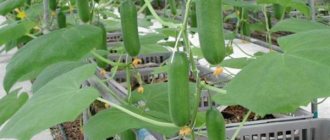Design Features
A trench greenhouse is a structure with solid walls, buried to the depth of soil freezing. This feature allows you to use the heat accumulated in the soil over several cold months.
Trench greenhouse
The walls of the greenhouse are made of heat-intensive materials and are insulated from the outside to avoid cooling from the upper freezing layers of the soil. Additionally, the soil is protected from freezing using an insulated blind area around the entire perimeter of the greenhouse.
The roof can be of any shape - arched, gable or pitched. It is covered with two layers of polycarbonate with insulation of the air space between them or frames with double glazing. When the greenhouse is oriented from west to east, the northern slope of the roof can be sewn tightly to reduce heat loss.
Trench greenhouse with arched roof
The entrance to the greenhouse is located at the end and is equipped with an insulated vestibule. To descend into the greenhouse, a staircase is made in the vestibule. You can also place heating equipment or a storage room for storing tools and planting material - tubers, cuttings and bulbs.
Stove in the vestibule of a trench greenhouse
The recessed greenhouse is equipped with a forced supply and exhaust ventilation system. For this purpose, plastic pipes and built-in fans are used. When using glazed frames, some of them can be made to open - in the summer this will help avoid overheating.
Fans for forced air exchange in a greenhouse
In the southern regions, in a trench greenhouse in winter the temperature does not drop below zero even without additional heating. In temperate latitudes, during frosts it needs to be heated. A stove, electric heaters or a water boiler can be used as a heating device.
Stove heating of a trench greenhouse
Effective heating can be achieved by laying a heating cable or water heating pipes in the ground. The heated soil is capable of releasing heat into the greenhouse space for a long time and warming the air.
Scheme of soil heating using an electric cable
Plants in a trench greenhouse can be placed either on beds or on racks. The beds are made of brick or concrete blocks - the walls are an additional heat accumulator. The height of the beds is made within 0.8-1.2 m so that the plants receive enough sunlight. Fill with organic components to obtain the effect of a warm bed and additional heating.
Raised beds in a trench greenhouse
When growing plants on shelves, it is better to concrete the floor, having previously laid waterproofing and insulation boards underneath it. In this case, it is better to place additional heating under the shelving.
Growing container plants and seedlings in a trench greenhouse
Greenhouse in the ground without heating
You are using an outdated browser. This and other sites may not display correctly. You need to update your browser or try using a different one.
Impregnations, paints, oils, waterproofing from FORUMHOUSE
FORUMHOUSE turns 15 this year! During this time, millions of people have built their own homes thanks to the knowledge gained from our website. We want only high-quality and safe materials to be used during construction, which will help preserve houses for many decades. Therefore, we have launched a project of our own FORUMHOUSE brand, under which we will produce building materials and equipment that will serve you for many years and make your life in your own home more comfortable and safer.
We started this project with paints and varnishes for wooden surfaces. Last year, hundreds of forum members have already tested and given positive feedback about our protective and decorative impregnation for wood. Now we have a full range of products for wooden houses (impregnations, paints, oils, varnishes and waterproofing).
In this topic, we will be happy to advise you and select the best solutions for painting your home!
Best regards, FORUMHOUSE team.
Participate in the chronicles of suburban self-isolation with FORUMHOUSE
Sitting at home outside the city is cool: you can walk on your property as much as you want without consequences, and you can also make repairs, sort out the rubble in the attic, take care of the garden, organize a vegetable garden, make a workshop, build a bunker in case of the apocalypse, in general, whatever you like. We are sure that many of you will have a list of achievements during quarantine, and we really want you to share them, supporting and inspiring forum members.
Take part in our “Staying at Home” project and you can receive a powerful cordless saw as a gift!
Disinfection saves the future harvest
- a whole class of drugs developed against specific types of bacteria: “Fitolavin-300” against pathogenic bacteria and rot, “Bayleton” – against gray rot and powdery mildew, “Acrobat MC” – against downy mildew and late blight. The use of these drugs must be preceded by familiarity with the recommendations.
All work is carried out only with your own hands - this is a guarantee that not a single nuance will be missed
- The covering material is washed thoroughly;
- Nothing will grow by itself. Maximum calculation, knowledge, work and discipline - this is what the earth loves - these are the components of a good harvest.
- After the entire internal area of the greenhouse has been “planted” with invertebrates, give them a little rain by watering the entire plantation with a watering can or hose. If there are no night frosts on the soil yet, then watering can be quite abundant.
However, this is only the simplest preparation of the soil for the next planting, and if you want to achieve maximum results, then you need to carry out a number of additional preparatory measures.
Underground greenhouses on noble estates
As soon as we decided to build an underground greenhouse in Prosperity, I immediately began to come across various interesting materials on this topic. I will collect the most interesting things.
Leo Tolstoy's underground greenhouse
Nowadays there is a lot of talk about underground greenhouses as a modern invention, but our gardeners had such greenhouses 150 years ago. One of them was preserved in the estate of the famous vegetarian, writer Leo Tolstoy in Yasnaya Polyana. Leo Tolstoy was not only a brilliant writer, but also an excellent gardener, agrarian, beekeeper and teacher.
On his small plot, he grew all the vegetables the family needed. Almost the same area as for the vegetable garden was allocated to Russian greenhouses. In the spring they were filled with manure, fortunately it accumulated in abundance: there were stables on the estate.
Count Tolstoy designed and equipped the underground greenhouse (it still operates to this day) with his own hands in the 70s on the site of a building that burned down in 1867.
the greenhouse of Prince N. S. Volkonsky. From the outside it is unprepossessing, with a low ridge and gently sloping glazing. But the snow quickly rolls off the roof and it’s quite light in the greenhouse. Inside, the greenhouse is two-level, spacious and high, as it is buried in the soil (almost 2 m). Earthen walls lined with timber retain heat.
At Tolstoy's, peach and cherry trees bore fruit in tubs; Turgenev has pears in greenhouses and greenhouses. Prince Vyazemsky had about a thousand such tubs, Turgenev also had a significant number: he had winter gardens... After the abolition of serfdom, more crops began to be planted in open ground.
This, of course, is less labor-intensive - after all, greenhouses need to be heated and ventilated...
In the museum greenhouse, pomegranates, figs, peaches, and coffee are now growing in tubs. Once upon a time, the Tolstoys grew coffee, mixed it with dried chicory roots, and even took it to Moscow for sale.
What kind of greenhouses, greenhouses and vegetable gardens were there in noble estates?
In addition to the popular landscape design that many homeowners are now keen on, greenhouses and greenhouses with exotic plants used to be an integral part of a noble estate.
The nobles kept greenhouses, greenhouses and hothouses in which fresh herbs, cucumbers, and exotic vegetables were grown to surprise their neighbors. Moreover, many estate owners did not consider it shameful to work in them.
Greenhouses, as a rule, were built of wood, and stone cellars were built for growing seedlings.
For many nobles, vegetable growing was a serious hobby, and sometimes one of the few joys in life. Like, for example, the Decembrists exiled to Siberia.
Greenhouse Museum in Tarkhany
Volkonskaya was the first in Eastern Siberia to plant carotel, dwarf beans, tomatoes, maize, celery, spinach, purslane, and tarragon. She had four types of melons - “Dubrovka, real, cantaloupe and Persian.”
Moreover, even in the courtyard of the Chita prison, Maria Nikolaevna, together with her husband, set up a small greenhouse and taught her friends to “plant a vegetable garden.”
The princess sowed cucumbers, with her own hands, on high manure beds for cucumbers in the yard behind the stables. From frosts, which happened even in July, the crops were covered with “felt and carpets.” “I,” the princess wrote to her mother-in-law in the fall of 1829, “have cauliflower, artichokes, wonderful melons and watermelons and a supply of good vegetables for the whole winter.”
Nevertheless, the composer’s father tried very hard to diversify the vegetation of the estate in order to somehow distract his French wife from sadness and pamper his children with rare vegetables.
He ordered to build a vegetable garden, insulate leaky greenhouses and build a greenhouse that would be in harmony with other buildings (a glacier with a pit for storing vegetables, stables, a barn).
The greenhouse was made of logs, with high and quite wide windows for those times for good illumination of the plants, had the shape of the letter L and was heated by special stoves. It had a room for a gardener, who monitored the heating of the room around the clock.
The owner himself did not work in the greenhouse, but carefully observed the plants. For example, in April 1837, he wrote in his work journal that “the cucumbers are already on their fifth leaf.” I. Tchaikovsky often visited the greenhouse and brought his children to harvest the crops.
This is a good example of what we should do in an era of shortages of natural products and a crisis in raising our children.
Do-it-yourself underground greenhouse - three years of operation, normal “flight”!
Adding an article to a new collection
Even without experience and being a city resident, if you have the desire, ingenuity and hard-working hands, it is quite possible to independently equip your dacha or village plot with various useful structures.
For example, build a real greenhouse for all seasons, and not just a simple one, but an underground one, as pensioners Alexander and Elena Bazylev from the Krasnodar Territory did! Today I will tell you how we created our underground greenhouse literally from scratch.
My wife and I retired and four years ago moved from the north, from the city of Kostomuksha, to permanent residence in the Krasnodar Territory.
The first year we built a house and did little gardening. Indeed, with age, a person is drawn to work on the land, and we enjoy it. Before this, we had never been involved in growing vegetables in our lives, and accordingly, we had no experience or knowledge.
It all started with the fact that I wanted to grow vegetables all year round. And for this it was necessary, of course, to build a winter greenhouse. In the evenings I sat at the computer and studied all the information I came across on this topic. What attracted me most was the idea of an underground greenhouse, however, I found only theoretical descriptions of it, so I had to figure out the construction technology myself.
I built the greenhouse alone, only my wife helped, and this meant holding something, handing it over and giving a bunch of “practical” advice. But now it's a real family project. Since I was not “burdened” with construction knowledge, there is a lot of my small “know-how” here, in particular, the booth - the entrance is on iron poles, and its wooden frame is made using pins and mounting angles. I came up with all this myself and I can’t imagine how it could have been done differently.
There were doubts about the feasibility of building such a greenhouse, and the neighbors laughed at my construction that had begun. But I needed earth to fill around the newly built house, so in the process I “killed two birds with one stone” - I dug a pit and found a use for the earth.
The local soil – loam – was ideal for building an underground greenhouse. I came up with the design myself, doing everything on a whim. After all, we are city dwellers, far from rural life; I have no construction skills. I started building a greenhouse in the spring and built it, without being distracted from my main tasks and garden, from time to time, all summer.
First, I installed the wooden perimeter of the future greenhouse, oriented from east to west. I secured the perimeter beam to the 50x50 mm corners, which I had previously cemented into short round pedestals (it turned out that the perimeter stood, as it were, on stilts). This, I think, should definitely be done.
Then I dug a pit measuring 5x3.5 m, a little more than 2 m deep. I dug by hand and took out about 300 wheelbarrows of earth to fill the house. And the rest of the soil was used to fill three walls of the future greenhouse above ground level.
Three years of operation have shown that almost everything was done correctly. The only mistake I made was when doing the drainage. The walls of the greenhouse above ground level along the entire perimeter are covered with roofing felt and galvanized sheeting with a bend along the ground of 0.5 m so that rainwater cannot seep into the greenhouse.
I started upholstering the first wall with used galvanized sheets - the bend along the ground turned out to be smaller, as a result, in one place on the wall the ground was washed away a little. What saved me was that on this side outside the greenhouse there is a natural slope. I did the angle of inclination of the highest wall above the ground “by eye,” so I can’t say how many degrees it is.
The entire structure of the greenhouse, all the wooden parts are clearly visible in the photo - they are all impregnated with an anti-rotting agent. The roof is covered with 10 mm polycarbonate, the walls above the ground are insulated with penoplex. All walls inside the greenhouse are covered with foil insulation, which is needed for light reflection and increasing illumination inside the greenhouse, and not for insulation. The entrance to the greenhouse is 1.2x1 m, the booth is also insulated with penoplex.
The lighting consists of six LED lamps, but this is not enough; for the next winter season I will install phytolamps. Heating in winter - one 1 kW oil battery and a 1 kW infrared heater. I turn them on mainly at night and at no more than half power, and during the day only in the coldest weather. During the first winter, only the oil battery worked and, in general, it was enough.
There are two big “troubles” in this greenhouse in winter: lack of light (the sun here is low on the horizon, and the sun’s rays do not fall into this hole) and very high humidity inside (you can’t open the doors and windows, it’s cold). I was able to solve both of these problems only in the third winter season.
The greenhouse has already flooded twice. The first time was the year before last, when there were heavy rains throughout May, and the water rose almost 30 cm. There is an aquifer nearby, so the water came and went from this side. The second time it flooded on New Year's Day, when a lot of snow fell in the last days of December, and then the temperature rose sharply to 17°C - this happens in these parts. The water then rose by almost 40 cm, it’s good that after the first flood I raised the height of the beds by one more board, and prudently laid out the floor in the greenhouse with cement blocks. What is most interesting is that the cucumbers were not damaged in any way, but I thought they would disappear, the cold melt water would destroy everything. But the sun was shining, and the water in the greenhouse seemed to be warming up too, and only two eggplants died.
And the greenhouse itself was not damaged in any way, the soil at the entrance was slightly washed away inside, and the beds did not allow the walls to be washed away. I tried to pump the water out with a pump, but it didn’t help for long, the water came out again. Both times the water stood for almost three days, and then slowly went away. It’s good that 100 meters from the house, at a slightly lower level, a river flows, and all the water went there.
Due to the lack of any experience, it seemed to me that if I just built such a greenhouse, it would work itself. In the summer, yes, it worked, but in the winter we managed to grow something only in the third season, when we finally figured out what and how to do.
A greenhouse was built in the Krasnodar region, and I don’t know how it will behave in other regions. But we liked the structure so much that I started building another underground greenhouse, and it will be very different from this one.
All people are drawn upward, towards the sky, but for me it’s something the other way around. This is probably because I worked almost my entire life as a BelAZ driver in my career, i.e. below the surface of the earth, and this is already a habit. Just kidding, of course.
But the story of how to operate this greenhouse in winter is a completely separate topic...
Features of year-round greenhouses
Conventional greenhouses covered with film or polycarbonate are not suitable for growing vegetables throughout the year. The temperature in them in winter frosts inevitably drops below zero, and heating such greenhouses can go broke.
Greenhouses for year-round use with heating
A permanent greenhouse, in which a stable microclimate can be achieved even in winter, has some features:
- capital, usually strip foundation;
- double glazing or cellular polycarbonate coating with a thickness of at least 6 mm;
- systems that provide the necessary temperature, lighting and humidity conditions.
Year-round greenhouse - photo
The design of the greenhouse can be different, and it usually depends on the region. So, in temperate latitudes and in the south, it is enough to install an ordinary gable greenhouse with double frames on a concrete or brick foundation. It is oriented from west to east so that the midday sun illuminates one of the slopes.
In the northern regions, for better thermal insulation and savings on heating, some techniques are used: burying the greenhouse in the ground, installing a main heat accumulator wall, and a vestibule.
Greenhouse for year-round cultivation of fruit and vegetable products
What you need to know about greenhouse construction
An earthen greenhouse is literally sunk into the ground. Part of it is located below the soil surface. Since in temperate latitudes, even in frosts at a depth of 1 m, the earth maintains a positive temperature, plants in such a greenhouse can be grown in winter with a full harvest. “Dugout” is intended for year-round farming. It is appropriate for regions with slight soil freezing and areas with low groundwater levels.
Attention! The deeper the structure is located underground, the more stable the temperatures will be throughout the year. In winter it is not cold, in summer it is not hot. Hence another name - thermos greenhouse.
There are two types of dugouts:
- Underground greenhouse. “Planted” to a depth of 1.5 m. Involves supplying stairs and creating passages between the beds.
- Recessed greenhouse. The beds are placed only 50-80 cm below the ground surface. Not as warm, but easier to build. Provides easy care of plants with the help of an opening roof.
The most common shape of a recessed thermos is a rectangle. The roof is made of film, glass, polycarbonate. The frame of the structure is made of metal profiles or wooden beams. As in a regular greenhouse, it is important for crops to receive solar heat, so the roof must be made and placed correctly.
Kinds
In order to have a harvest of fresh vegetables and fruits all year round, use:
- single-pitched structures;
- gable;
- arched;
- block structures.
A lean-to greenhouse can be called the simplest structure. Such greenhouses can often be seen attached to the main residential building.
Lean-to greenhouses have the following advantages:
- the design is inexpensive;
- has good thermal insulation properties, since the main wall creates an additional heat source;
- no snow cover remains on the sharp corners of the slope.
Single-pitched greenhouses are used only for home use, where you can grow fresh herbs for the table all year round or set up a winter garden. They are not used for industrial buildings.
Gable greenhouses are located from north to south. They are a separate building with different lengths and widths up to 12 meters.
This structure has its advantages:
- used in small farming, suitable for private use;
- can have different sizes: from 30 to 300 sq. m, which allows to reduce heat loss in the room;
- building with good thermal insulation and lighting.
A hangar greenhouse is a structure made of a gable or arched structure and has a maximum width of up to 25 meters. Due to the fact that there are no racks inside the greenhouse, you can make maximum use of the space inside the structure. Hangar greenhouses have a large width and a roof angle of up to 30 degrees, which means additional costs will be required to provide heating. For coating, reinforced film or polycarbonate is often used.
Hangar greenhouses have the following advantages:
- thanks to their design, plants receive the maximum amount of lighting;
- there is the possibility of using mechanics for maintenance;
- There is no need to remove snow from arched structures manually, as it comes off on its own.
Block structures are a series of greenhouses that are connected at the sides. A support post is placed at the junction points, which will reduce costs. The roofs are divided into separate sections with gutters for water drainage. Block structures can have different lengths - sometimes it reaches more than one hectare, so this type of greenhouse is used only for industrial use.
The advantages include the following:
- the cheapest design for industrial needs;
- has high resistance to wind and snow cover;
- all parts of the greenhouse have excellent lighting;
- you can easily place all systems for operation: heating, watering, lighting;
- the greenhouse is easily ventilated through the roof, on which vents are placed.
The disadvantages of this design can be considered that only up to 70% of the area is used. In addition, melt and rain water begins to accumulate in the recess on the roof, which requires an additional system for melting snow and draining melt water. Block tables are used only for industrial needs; they are not recommended for use in private households due to their size and cost.
If you plan to build a greenhouse on a small plot of land, underground or in-depth buildings are best suited, although for many, greenhouses built in the form of a house or an arched structure are familiar. If you build structures of this type, the plants will receive 20 to 35% sunlight, and when cold weather sets in, they will be quite cold.
School physics teacher Ivanov proposed a different construction option with a pitched roof, which has a slope of 20 degrees and a tightly closed wall at the back, which allows maximum use of solar energy. Thanks to this design, you can get a harvest much longer.
The construction technology is called Scandinavian, as residents of European countries with harsher climates began to use it. This unique design has virtually no disadvantages. Its main feature is that, thanks to a certain slope of the roof, the sun's rays do not slide across the surface, but fall perpendicularly - this allows you to harvest the crop much earlier.
Peculiarities
Many summer residents are accustomed to greenhouses, inside which temperature changes are felt. For greenhouses that are located in the ground, these disadvantages do not exist. In such buildings, the walls work like a thermos, so you don’t have to spend a lot of money on heating and electricity. A thermos greenhouse allows you to obtain a harvest of fresh, juicy vegetables and herbs all year round.
Underground structures are suitable for growing annual plants and perennial crops. In the greenhouse you can plant small ornamental and exotic trees and shrubs, and here you can also organize the production of roses or other flowers. Such a year-round greenhouse will allow you to regularly collect vegetables, fruits, herbs and citrus fruits not only for your own use - gardening products can be sold on the market, thereby creating your own small business.
Trench greenhouse made of thermoblocks
Thermoblocks are permanent formwork made of polystyrene, which has sufficient rigidity and low thermal conductivity. The blocks are installed on vertically fixed reinforcement in the form of a wall and filled with concrete. Construction from thermoblocks is carried out quite quickly, and the walls are durable and well insulated.
Thermoblocks
Private wall block, lock
The greenhouse shown in the illustrations is oriented from west to east and has a gable roof with varying sizes of slopes. The northern slope is covered with OSB sheets and soft tiles, the southern one is made of 10 mm cellular polycarbonate. To improve illumination in the greenhouse, additional lighting with HPS lamps is provided.
Step 1. Mark the area and dig a pit for the greenhouse using the technology described above.
Pit preparation
Step 2. Install the formwork under the foundation and reinforce it using a corrugated rod Ø12-14 mm. The reinforcement is placed in two horizontal rows at the level of the foundation and installed vertically to the height of the walls. The intersections of the reinforcement are knitted using annealed wire. The foundation is poured with concrete and left for 15-25 days to gain strength.
Pouring the foundation and reinforcement for installing thermoblocks
Step 3. Treat the foundation with liquid bitumen waterproofing in several layers. Fill the bottom of the trench with sand and level it.
Foundation waterproofing
Step 4. Install the first row of thermal blocks and fill them with concrete. When cracks appear, the joints of the blocks are coated with cement mortar.
Construction of formwork from thermoblocks
Step 5. Every three rows it is necessary to perform horizontal reinforcement using corrugated rods. They are placed on special guides in thermoblocks.
Subsequent rows of walls
Step 6. Upon reaching the ground level, the outer side of the masonry is wrapped with rolled waterproofing, covered with sheets of flat slate and backfilled with soil.
Scaffolding
Step 7. Continue laying the above-ground part of the walls using the same technology. Perform door and window openings.
Greenhouse ends
Step 8. Fill the side ends of the greenhouse. Thermoblocks for them are cut to size according to a template.
View of the greenhouse from the other side
Step 9. The top row of masonry is reinforced with horizontal rods. After pouring and hardening of the concrete, the excess part of the vertical reinforcement is cut off, and the upper edge of the walls is leveled with cement-sand mortar.
Leveling the top of the walls
Step 10. According to the sketch, trusses are made from a metal corner 50x50 mm. Clean the welding areas and cover the trusses first with a primer, and after it dries, with light-colored metal paint.
Rafter truss
Step 11. Install the trusses into place, securing them to anchors in the concrete pouring of the thermoblocks.
Installation of rafters
Step 12. Using cross beams, the trusses are connected into a single structure. For sprockets, you can use a metal strip 20-30 mm wide.
Installation of shrouds
Step 13. The northern slope of the greenhouse is covered with a moisture-resistant OSB board.
The back wall is covered with OSB
Step 14. The walls of the greenhouse are plastered and, if desired, painted with weather-resistant paint.
Plastering greenhouse walls
Step 15. Cover the OSB board with flexible tiles. Wind and cornice strips are installed.
Covering the northern slope with soft tiles
Step 16. The southern slope is sewn up with polycarbonate 10 mm thick with a reinforced structure. When laying polycarbonate sheets, special profiles and screws are used. The ends must be insulated with adhesive tape and an end profile.
Covering the southern slope with polycarbonate
Step 17. Due to the large number of blank walls, the lighting in the greenhouse during the winter months is insufficient for most crops. Therefore, it must be equipped with lighting based on gas-discharge or LED lamps.
Additional lighting in the greenhouse
Video – In-ground greenhouse
A trench greenhouse is an expensive structure, but with active use it pays for itself in two to three seasons. In it you can grow not only the usual vegetables and herbs, but also southern fruits - citrus fruits, persimmons, pomegranates, pineapples. This greenhouse is also suitable for growing seedlings, rare flowers and ornamental plants.
DIY thermos greenhouse
If you want to provide yourself with fresh vegetables and herbs all year round, and not just during the short summer, then you cannot do without a greenhouse. But at the same time, the greenhouse that you need to build on your site will be unusual. This design is commonly called a “thermos” because it retains heat in the same way as a camping thermos keeps tea or soup poured into it hot.
And, of course, a thermos greenhouse can be made in almost any region of Russia (with the exception of permafrost zones). Although to create it you will have to spend not only more of your effort and time, but also finances, since you will not be able to assemble it from scrap materials.
Expenses
You will definitely need: concrete or FSK, a metal profile pipe or wooden beam, transparent polycarbonate and many fasteners.
In addition, if your area has poor soil (with stones), then you may need the help of an excavator, otherwise, instead of a greenhouse with vegetables, you will get a headache for a very long time (while you dig the pit by hand).
Preparatory work
Laying the walls of a thermos greenhouse
Construction of a greenhouse should begin by determining the location where you are going to install it.
If you are going to use the services of an excavator, you must immediately consider the possibility of its passage through your land plot.
And do not forget that a thermos greenhouse is a capital structure that you cannot easily disassemble and move to another place. Therefore, choose a place for it, taking into account the fact that there should be no trees nearby that block sunlight, as well as similar buildings (existing or future) operating in a similar way.
For maximum illumination of the greenhouse throughout the day, it is recommended to “stretch” it in the west-east direction. Experts consider the maximum width of a thermos table to be 5 meters, with virtually no limit to its length.
Also think about the issue of heating your plants, because a thermos greenhouse, created with your own hands, in severe cold weather will not be able to independently maintain a temperature of 25-35 degrees without your help.
Construction
Heating in a greenhouse
Having chosen a place for the greenhouse and decided on its size, you can begin excavation work.
In order for the greenhouse to work as a real “thermos” for plants even on cold winter days, the depth of the pit must be (in central Russia) at least 2 meters.
It is at this depth that temperature fluctuations will cease to be felt in winter (while on the surface of the earth it can even be -30 degrees).
- Polycarbonate roof for a greenhouse Lay out the walls from FSok along the perimeter of the thermos greenhouse. If you don’t have this building material, you can make them from concrete, just don’t forget to reinforce it so that the soil from the sides doesn’t tip it inside the greenhouse with its pressure. Be sure to leave rebar outlets, which will later become part of the top wall.
- Lay out the walls of the greenhouse from thermoblocks. Their height should cover the maximum snow cover in your area by at least 50 centimeters.
- If in the future the roof of your greenhouse will be mounted on a metal frame, immediately secure the profile pipes that make it up in the right places, “threading” them through thermal blocks and welding them to the reinforcement outlets from the foundation - this will make the greenhouse design even more reliable.
- The inside of the thermoblocks should be covered with reflective thermal insulating film. If it is very cold in your area in winter, then it is better to lay the film in two layers.
- Assemble a polycarbonate roof frame. It can be made single-pitched, gable or semi-circular (in this case you will not have to worry about snowdrifts appearing on it). If you decide to make the frame from wooden blocks, be sure to impregnate them with a protective compound that will prevent them from rotting.
- To better retain heat inside the greenhouse, polycarbonate can be laid in two layers with a small air gap between the sheets. This method is especially good if you plan to use the greenhouse year-round or grow exotic plants there (for example, pineapples, citrus fruits, etc.). However, two layers of polycarbonate reduce natural light in the greenhouse by approximately 10%.
- After installing the roof, make sure that the greenhouse does not have any gaps through which cold air will enter. Any defects found in the walls can be filled with cement-sand mortar or blown out with foam. Glue the corner joints of polycarbonate with transparent tape for reliability.
Single-pitch structures with wooden walls
This construction option is more economical than greenhouses with a gable roof. The frame of the building consists of three rows of wooden posts placed in a pit. On the north side, the first row is 20 cm lower than the middle one and is covered with a slab. Eighty centimeters from it there is a middle row, sheathed to the height of the ridge. In the resulting hole I place biofuel sprinkled with earth (10-15 cm). A roof is built above these racks, into the cavity of which sawdust is poured.
The racks on the south side are made 30 cm above ground level and are completely covered with slabs. The walls are covered with earth on both sides. On the north side, the roof lined with roofing felt is also covered with it. A chimney pipe is constructed on the floor in the working area. And a flooring is laid above it, on which shelves with earth are placed, leaving space for free access to them. This greenhouse can be used all year round. In the absence of heating, it can be used from the first months of spring until the onset of frost.
What tomatoes are happy to grow on
Here is another spring version of the “pie” for tomatoes:
If you are not a fan of mineral fertilizers in greenhouse soil, and you also don’t want to add manure or chicken before planting tomatoes (at least for fear of later becoming infected with helminths), then consider the option of green manure. This green fertilizer is planted in early spring, long before you bring in the first seedlings.
And here are the ideal predecessors of greenhouse beds for tomatoes:
- The price of an exact solution to the question of how to cultivate the soil in a greenhouse in the spring is a harvest that will justify all spring worries
- - this well-known drug shows itself perfectly against the pathogens of powdery mildew, late blight, rot, scab, curl and bacteriosis. The use of copper sulfate has a negative effect on plants, so it is available for use only in the fall. Concentrations higher than 10% are not used. Copper sulfate is part of the Bordeaux mixture
- Temperature method
- If you are lucky with the sun, then the following actions can help:
- It’s not enough to build a greenhouse on the site, get some unusual seedlings and place them in the soil, waiting for the harvest. The soil requires constant care, whether it is outdoors or in a greenhouse.
- carefully place the worm in it,
- Humus is poured onto its bottom, which has waited at least 3 years for this procedure. It must be remembered that it should not contain either straw or hay, since this significantly increases the time of its decomposition in the ground.
- Fertilizers are applied depending on the variety (a professional sales consultant should explain to you in detail how, how much, and when).
- Step 1. Place reeds and long-rotting branches as the bottom layer.
Green manure quickly forms a green mass and is often grown in a greenhouse only to be used as an organic fertilizer with valuable nitrogen. As a result, only 3 kg of green mass will replace 1-1.5 kg of manure! These are beans, peas, seradella, mustard, lentils, soybeans, rapeseed, phacelia, rapeseed and broad beans.
Features of construction technology
There are quite a lot of drawings of such greenhouses with different structures on the Internet. In addition to depths of up to 80 cm, common models have an above-ground part at the level of 1.1-1.5 m. The width does not exceed 5 m, but the length can be much greater. The roof structure divides greenhouses into several types:
Experts advise considering the following nuances before building a greenhouse:
- On a plain with frequent cold winds, the greenhouse should be additionally protected. It is enough to place a fence, but not too close to the structure itself.
- Daylight should reach the greenhouse beds in the maximum amount for a given area.
- Consider for yourself a convenient approach and the possibility of working with the structure.
All borrowed drawings must be adapted to the conditions of your site, taking into account the topography and location of buildings. Careful measurements and markings are required. Use them to start digging a pit. A recessed greenhouse rests on the walls, so it needs a simple foundation to the depth of future beds. Line the perimeter with thermal blocks and fill with cement mortar. This foundation hardens for about a month.
Attention! A small greenhouse can be erected without a foundation. A prerequisite is sufficient soil hardness.
Polycarbonate greenhouse
When using polycarbonate as a material for covering the frame of a wall-mounted polycarbonate greenhouse, you should remember the following rules:
- carefully measure the material;
- make holes at a distance of 4-5 cm from the edge. Polycarbonate will not crack at the drilling site;
- Use reinforced tape to cover all joints and cavities. This approach will allow you to insulate and maintain the microclimate even in winter;
- use thermal washers;
- Do not over-tighten the fasteners. The polycarbonate sheet should not bend under the influence of the fastener.
- seal the remaining cracks with foam or plaster;
- conduct electricity and other systems;
How to build a thermos greenhouse - step-by-step instructions
Step-by-step instructions with visual photos will help you decide on materials, understand the order of construction of a buried greenhouse, and, as a result, make a compact dugout for your dacha using your own resources.
Step 1: preparation of materials and tools
The main structural elements of a greenhouse buried in the ground: walls, frame and roofing.
Thermoblocks are mainly used for walls. The building material consists of polystyrene foam walls connected by jumpers. The blocks are used as formwork, and after installation they are filled with concrete. The result is a durable and insulated wall.
Thermoblock for the construction of a recessed greenhouse
The roof frame is constructed from metal profiles or wood. The first option will provide adequate strength and wear resistance, but processing metal structures requires skills in working with a welding machine. It is easier to make a frame from wooden slats and treat it with protective impregnation.
The following are used as shelter:
- film - low cost, but limited service life - 2-3 years;
- glass – fire resistance, sufficient transparency, but the “sheathing” is fragile and expensive;
- polycarbonate - impact resistance, ductility, resistance to UV rays, service life - up to 10-15 years.
Cellular polycarbonate for covering greenhouses
The optimal solution for an underground thermos greenhouse is 6 mm thick cellular polycarbonate.
In addition to the materials described, to build an underground greenhouse with your own hands you will need:
- reinforcement, cement, crushed stone and sand for the foundation;
- polystyrene foam boards and reflective film for additional thermal insulation;
- plaster mixture;
- fasteners: screws, nails, nuts.
Required tools:
- jigsaw;
- bayonet and shovel shovels;
- concrete mixer;
- hammer;
- pliers;
- Master OK;
- tape measure, plumb line and level.
Pit preparation
Step 2: how to make the base of the greenhouse
The basis of the greenhouse in the ground is the foundation in a prepared pit. Therefore, the first stage is marking the site for an underground greenhouse and carrying out earthworks.
As a rule, the area of underground construction is 10-50 square meters. m. It is very difficult to handle such a volume on your own, so it is better to use the services of an excavator. The walls of the dug pit must be leveled with a shovel to achieve the desired dimensions.
At this stage, it is worth considering the need and methods of an additional heating system - whether a communications supply will be required.
The next stage is laying the strip foundation. It can be replaced with concrete blocks. If the thermos greenhouse is partially buried in the ground, then the base rises to the full depth of the pit or slightly above the middle.
Sequencing:
- Prepare wooden formwork - place wedges at a distance of 30 cm inside the perimeter of the pit. Make sides from the boards. Immediately mark the place under the door - do not pour the foundation here.
- Mix gravel and sand in equal parts and fill the trench. The thickness of the “pillow” is 10 cm.
- Weld the reinforcement block. The reinforcing frame must consist of at least 4 rods.
- Install the armored belt on the sand and gravel backfill. It is necessary to remove the metal protrusions - they will fix the thermal blocks and the base of the canopy will be attached to them.
- Combine sand, cement and crushed stone (5:1:3), add water and knead the solution.
- Fill the formwork with the prepared mixture.
Installation of formwork for concrete pouring
Work continues after 25 days - the foundation should gain strength. At the end of the period, the formwork can be removed and the concrete base treated with bitumen mastic to protect it from moisture.
Step 3: constructing the frame
To increase the height of the underground greenhouse, thermal blocks are placed through which metal rods from the foundation are threaded. The voids in the blocks are filled with concrete. The entrance is framed with wooden beams.
The height of the walls of a recessed thermos greenhouse is at least 50 cm. This value is enough so that in winter snowdrifts do not clutter up the covering material and do not interfere with the flow of light.
Raising the walls of a thermos greenhouse above ground level
Before constructing the frame, the greenhouse is thermally insulated. The inner part is lined with foil insulation - due to the reflection of sunlight, heat accumulation will increase.
Next, we begin to install the roof. If you are making a greenhouse with your own hands for the first time, then it is better to make a wooden support frame:
- Prepare the parts of the rafter system and treat the wooden blanks with an antiseptic.
- Connect the rafters and reinforce them with metal corners.
- Form a support from the rafters and place a ridge beam under them.
- Connect the outer rafters to the beam using self-tapping screws.
- Install jumpers on the front support between the flashings and rafters.
- Paint the wooden frame.
Thermal greenhouse roof truss system
Step 4: Covering the Greenhouse
Polycarbonate is fastened using:
- roofing screws;
- connecting profile;
- self-tapping screws with a thermal washer made of polymer.
The sequence of covering an underground greenhouse-thermos:
- Using a sharp knife or jigsaw, cut a polycarbonate sheet to the size of the roof. It is important not to damage the stabilizing coating.
- Place the workpiece on a flat surface, mark the attachment points with a marker and drill holes.
- Glue the ends of the polycarbonate with sealing tape.
- Attach the canvas to the frame with the stabilizing side facing outwards and, holding it, screw in the screws. Fasteners must fit perpendicularly into the polycarbonate.
- Join adjacent sheets through a connecting profile.
- Secure an iron roofing angle along the ridge beam.
Covering the thermos greenhouse with polycarbonate
In the roof of the underground greenhouse it is necessary to provide folding windows for ventilation.
Step 5: setting up a thermos greenhouse
Organization of the internal space of an underground greenhouse includes:
- laying out beds;
- framing paths;
- creation of a fertile layer;
- electricity supply.
The number and size of the beds depend on the width of the thermos greenhouse. Layout nuances:
- the maximum width of the ridge is 1-1.2 m - if this indicator is exceeded, it is not convenient to care for distant plantings;
- if space is limited, 2 beds are laid out along the longitudinal walls, in the center - a path with a width of 50 cm;
- if three parallel planting strips fit, then the permissible center width reaches 1.5 m - crops can be cultivated from versatile passages.
Layout of beds in a sunken greenhouse
Due to the high humidity in a recessed thermos greenhouse, uncovered earthen paths quickly become slippery, and after watering, puddles form on them. Improvement of passages:
- Install limiting sides - height 5 cm above ground level.
- Line the paths with bricks, pieces of blocks or wooden boards.
Raised beds 25-30 cm high are suitable for a pit greenhouse. The framing is done with strips of flat slate, metal or wood. Pegs are installed to support the border. Fertile soil is poured inside the formed box.
Possible soil mixture options:
- sand, soil, humus, peat (1:1:3:5);
- chopped straw, peat, cow dung (1:2:1).
Finally, electricity is installed, the door and locking hardware are installed, and lighting fixtures are installed.
Features of the construction of an in-depth greenhouse
The choice of location for a greenhouse building is a determining factor in this matter.
Agronomists suggest finding a suitable location on a hill or on a flat area to avoid flooding of the structure. Gardeners note that the larger the greenhouse, the more stable the microclimate it maintains. For this reason, you should not save on the construction of a large greenhouse. In addition, the gardener needs to consider:
- Direction of the wind. Air masses create a draft, which is why you have to spend a lot of money on heating the underground building.
- Relief. Many farmers build a buried greenhouse with their own hands on the slopes of hills. Thus, they save on walls and heating.
- Lighting. Trees should not grow near the building, which, with their shadow, prevent the penetration of sunlight.
A universal type of earthen greenhouse is a gable greenhouse with brick walls. The foundation pouring depth is 80 cm when using a strip base. The walls are erected in one brick, coating all joints with waterproofing mortar. At the same time, they are reinforced with vertical metal fixtures. The optimal roof slope is 25˚. It is constructed of glass or polycarbonate. You can even grow garden crops in such a thermos greenhouse.
Project of a lean-to in-ground greenhouse
Buildings of this type are constructed from a wooden frame consisting of 3 rows of posts.
The height of the greenhouse room is determined by the base to which it will adjoin. The dimensions of the outer side of the structure vary from 160 to 180 cm. The frame of the greenhouse is made of three types of material:
- wooden beams;
- profiled pipes;
- polyvinyl chloride profile.
To lay the foundation, you also choose one of the proposed options: larch beams, concrete mortar or brick blocks.
A harness is formed in the lower and upper parts of the supporting frame. Next, it is strengthened with struts and slopes, which are installed under the rafters and between the racks. Then they think through holes for windows (on the roof), as well as doors. The casing is made of polycarbonate (100 mm). In such a complex process, diagrams and drawings of the building will become assistants to the gardener. The exact dimensions of a recessed lean-to or gable greenhouse will help the farmer build a reliable and practical building that he will use for decades.
We show the pros and cons of a buried greenhouse
There are two types of insulated rooms.
In one case, the walls are completely buried in an earthen ditch, and in the second - only a part, because only 60 cm of the building is in the ground. To build a thermos greenhouse, dig a pit measuring 2 times the freezing depth of the soil. In this case, the occurrence of groundwater is taken into account, although agronomist experts advise equipping a powerful drainage system. As a result, an underground greenhouse for year-round gardening will be able to:
- last for decades;
- operate in all weather conditions;
- become an ideal place for growing herbs, vegetables, seedlings, and flowers;
- preserve a rich harvest in short summer conditions;
- provide plants with heat without additional installation of heating equipment.
Professionals recommend covering a sunken greenhouse with polycarbonate. The material is particularly strong, flexible, durable and thermally insulating.
Ultraviolet rays penetrate into an earthen building through the roof. Therefore, the farmer does not need to worry that his crop will be destroyed by the scorching sun. In addition, this system of growing crops allows you to save on watering. Thanks to the unique structure of the greenhouse, the earth warms up moderately, retaining a sufficient amount of moisture needed by the plants. However, the pros and cons of a buried greenhouse do not end there. The negative aspects of such a capital project include significant costs associated with the construction of a thermos greenhouse.
Cons of an underground greenhouse or finances sing romances
The construction of a greenhouse structure is equivalent to the construction of a small house. A very deep trench is dug under its foundation. In the northern regions or Siberia, farmers have to immerse the building to the maximum depth, because the ground in those places freezes to 1.5-2.5 meters. This, in turn, comes with even greater costs. The main problem when building a greenhouse in the ground with your own hands is often groundwater, which does not allow it to penetrate so deeply into the soil.
In addition, additional funds will be needed in the event of:
- strengthening walls with insufficient soil density;
- construction of a suitable drainage system;
- construction of a strong supporting frame;
- installation of a heating system, because the harsh winters of northern latitudes are merciless.
According to all the rules of agricultural technology, in-depth greenhouses are equipped with a powerful ventilation system. This standard recommendation should not be neglected. Otherwise, mold and fungal infections will become true friends of the gardener and the crops he grows.
Still, if he has the necessary capital, the farmer needs to invest money in this worthwhile business. If he plans everything carefully, he can even launch a successful business and ultimately make a good profit. But how to build an underground greenhouse without causing damage. To do this, it is important to know some of the subtleties of constructing a greenhouse.
Underground greenhouse
It implements the idea of preserving the heat of the earth itself. It is no secret that at a certain depth the average temperature practically does not change throughout the year, remaining virtually unchanged there in winter and summer.
The introduction of this factor in the design of the greenhouse allows you to get huge savings in funds that are spent on heating in the winter; such a greenhouse means ease of maintenance and a measured local climate in its internal space.
The underground structures should be oriented east-west according to their ability; in this case, one of the sides of the greenhouse will be very illuminated by the sun, while the other side must be painstakingly thermally insulated using mineral wool or polystyrene foam.
Bio-vegetarian and underground greenhouse
Despite the in-depth base, the upper part will still be carried out according to the general rules for installing greenhouses. The owner will also be faced with the question of choosing a rational shelter option.
Which greenhouse is better - polycarbonate, film or glass? The first method works better in full-fledged structures of a traditional type; film, as previously mentioned, is the most affordable option, and glass can become an intermediate version, suitable for objects with increased requirements for thermal insulation.
Depending on the scale of the planned greenhouse, the dimensions of the recess are determined. The standard parameters of such structures are 1.5 x 2.5 m. However, the depth can reach 1 m
It is important to consider the location of the object on the site
Depending on the size of the year-round underground greenhouse, the method of organizing the base for the frame and, accordingly, the parameters of the pits are determined. After arranging the niches for the pillars, they should be lightly covered with crushed stone or gravel, and then filled with water.
The load-bearing elements are installed like a conventional foundation, in other words, using cement mortar. When the mixture completes polymerization, you can begin building the frame.
Further construction work
The walls of the greenhouse are erected from any heat-resistant material. For example, from polystyrene foam. To add rigidity, greenhouse walls are additionally reinforced. Even at the stage of their rise, take care of the necessary hydro- and heat-insulating procedures. Lubricate the openings between the blocks with a special solution and fill the cavities with foam. It is recommended to cover the inside of the wall with a foil-based thermal protective film.
Polycarbonate is optimal for the roof. It retains heat best. Sheets of material are laid in 2 layers, between which a wooden profile is placed. Pre-treat the wood with anti-rot impregnation.
- Connect the components of the lumber skeleton using the half-tree method.
- Paint the finished structure white.
- Fasten polycarbonate sheets with self-tapping screws. First - the inner layer, then - the outer one.
The proposed option for a recessed greenhouse is basic. Craftsmen complicate it at their own discretion:
- organize additional lighting;
- pour the heated floor mechanism under the screed;
- place plastic bottles or a barrel of water in the middle to slow down heat transfer;
- warm up the atmosphere using vermicompost and “warm” beds technology.
A greenhouse buried half a meter will allow its owners to significantly extend the gardening season. However, in the cold, even a technologically advanced design cannot cope on its own. She needs painstaking care, temperature and humidity control, and care for plant health.











